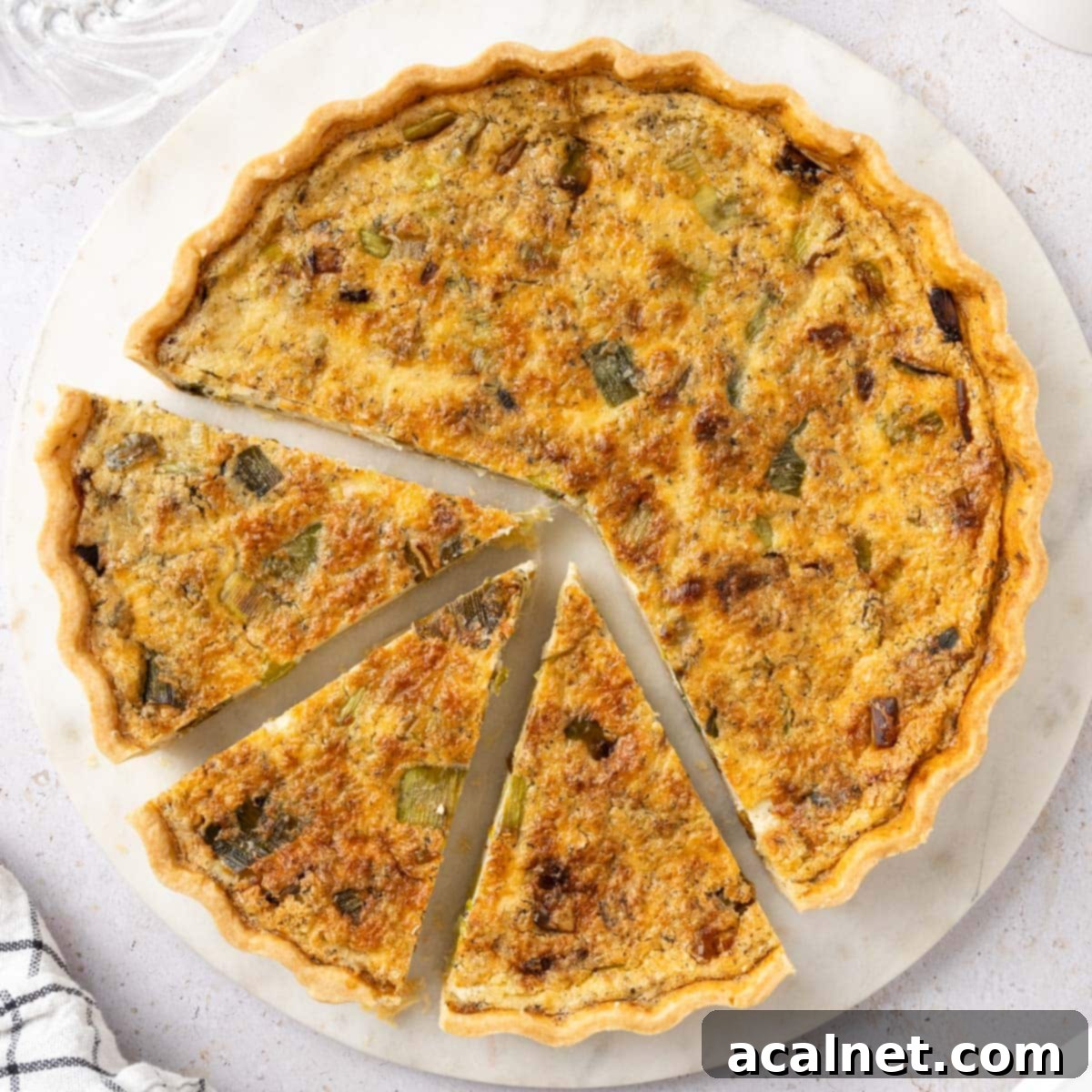Creamy Leek and Gruyère Quiche: The Ultimate Vegetarian Recipe
Indulge in the exquisite flavors of this Leek Quiche with Gruyère Cheese, a truly delightful vegetarian dish that transcends mealtime boundaries. Whether you’re planning a lavish breakfast, a leisurely brunch, a satisfying lunch, or a light yet comforting dinner, this quiche is an impeccable choice. It features a perfectly buttery and flaky homemade quiche crust, generously filled with a fluffy, rich, and cheesy custard mixture, brimming with tender, caramelized leeks. Every bite offers a harmonious blend of textures and savory notes, making it an instant favorite.
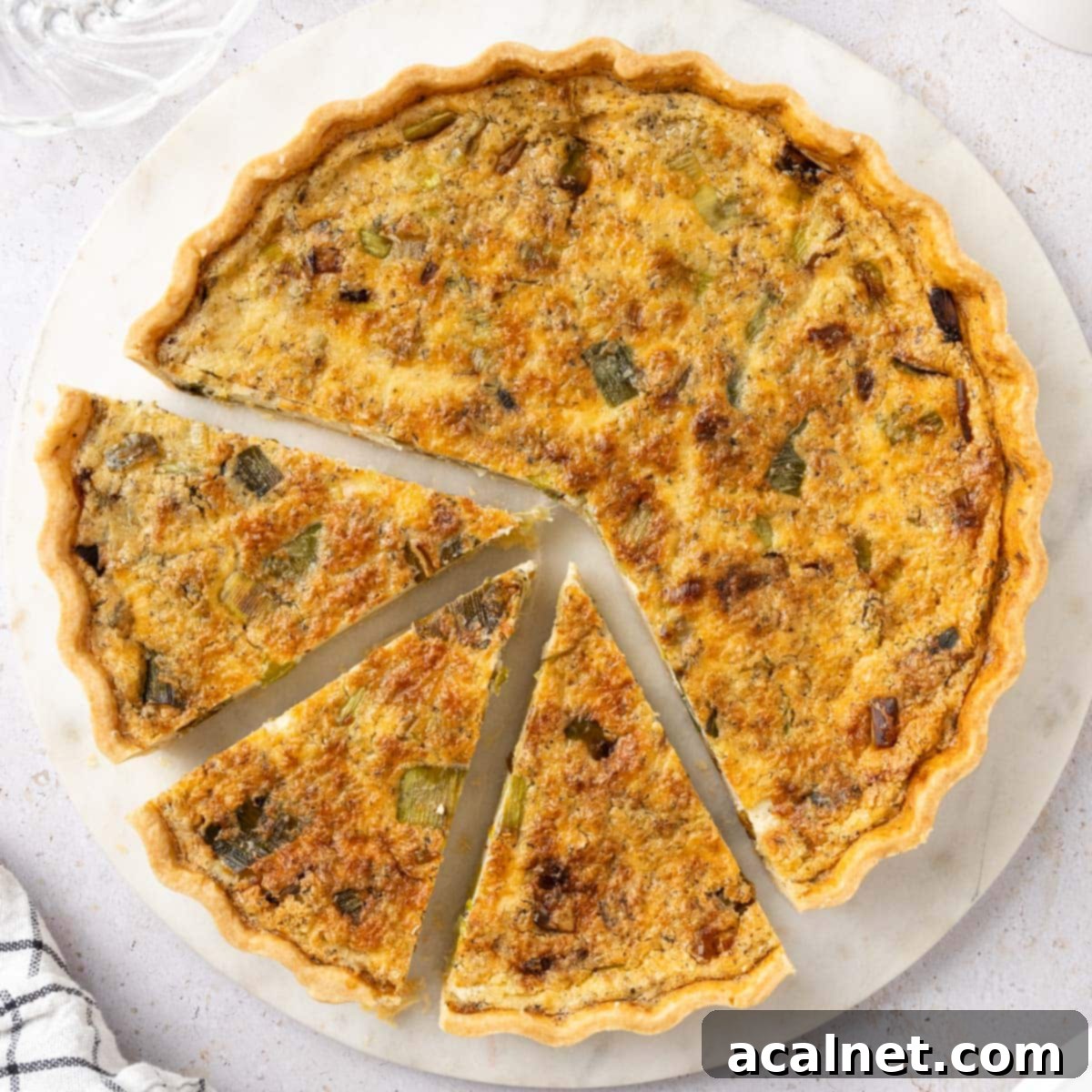
Why This Leek & Gruyère Quiche is a Must-Try
This Leek and Gruyère Quiche isn’t just a recipe; it’s an experience. The magic lies in the perfect combination of a homemade, tender shortcrust pastry, a velvety egg custard, the distinct nutty flavor of Gruyère cheese, and the sweet, savory notes of carefully sautéed leeks. It’s truly a crowd-pleasing dish that brings sophistication and comfort to any table.
What makes this leek quiche truly special is its incredible versatility. Imagine starting your day with a warm slice for breakfast, enjoying a satisfying piece for lunch, or serving it as an elegant main course for dinner. Its robust yet delicate flavors make it suitable for every moment of the day.
Beyond its delicious taste, this savory tart is incredibly practical. It can be prepared and baked in advance, making it an ideal candidate for meal prepping for the week or effortlessly entertaining guests at a brunch party. Simply store it in the fridge for a few days, and when you’re ready, a quick reheat brings it back to life. Plus, it freezes beautifully, allowing you to enjoy this culinary delight whenever a craving strikes.
Looking for more delicious leek recipes? Explore these favorites:
Leek & Smoked Salmon Quiche,
Leek & Mushroom Quiche,
Leek Tart with Onions & Gruyère.
Essential Ingredients for Your Perfect Leek Quiche
Crafting a magnificent quiche begins with selecting the right ingredients. Here’s a detailed look at what goes into our Leek and Gruyère Quiche, along with some insights and substitution ideas.
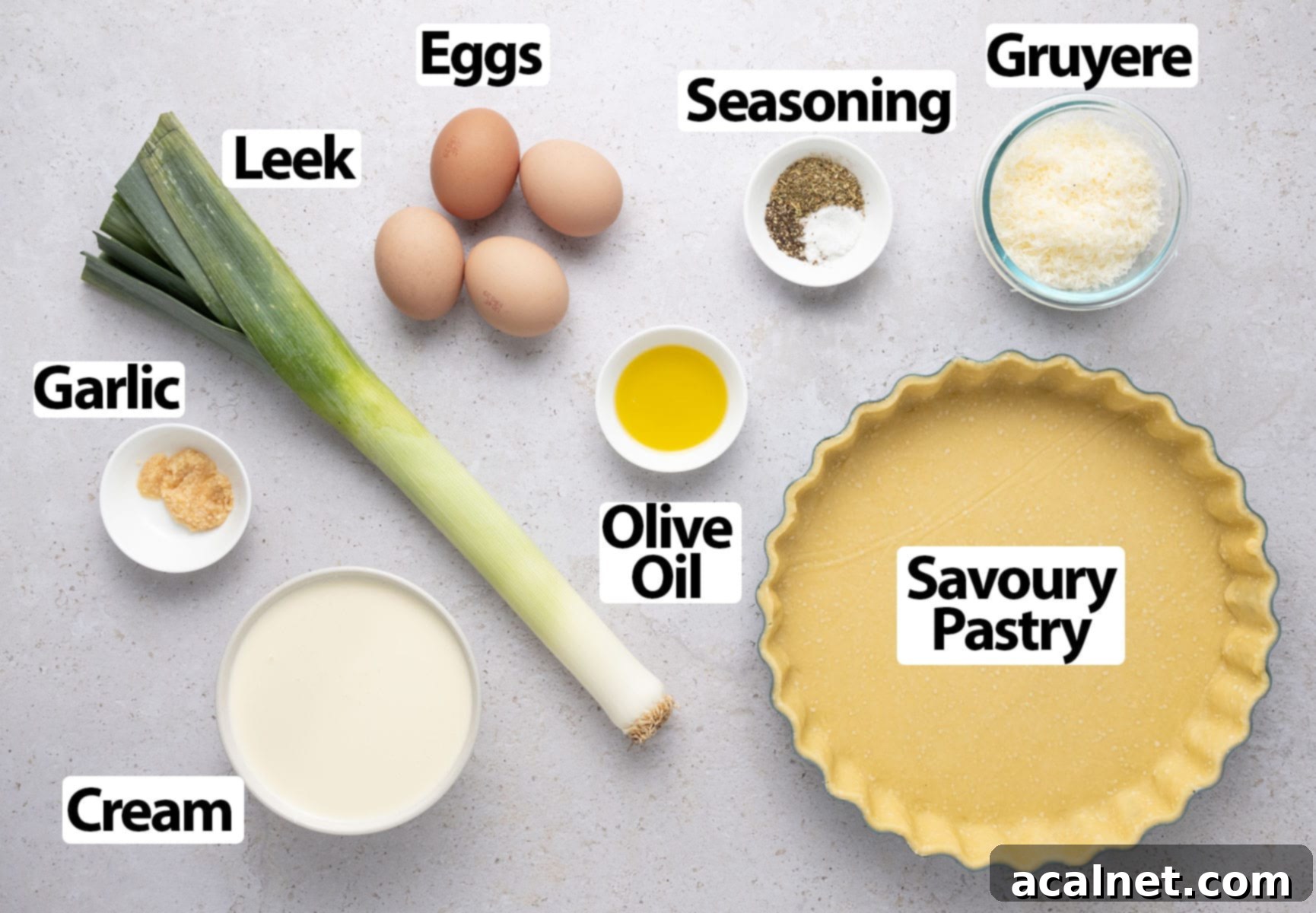
For precise measurements and quantities, please refer to the comprehensive recipe card below.
The Perfect Quiche Pastry
- Plain / All-Purpose Flour: The foundation of our crust. Using all-purpose flour provides a good balance of structure and tenderness.
- Fine Sea Salt: Essential for seasoning the pastry, ensuring it’s not bland.
- Unsalted Butter (very cold & cubed): This is crucial! Cold butter creates pockets of steam during baking, resulting in that irresistible flaky texture. Cubing it helps it incorporate more evenly into the flour.
- Cold Water: Just like butter, cold water prevents gluten from developing too much, keeping the pastry tender rather than tough.
Flavorful Leek Filling
- Leeks: We utilize both the white and most of the green parts for maximum flavor and visual appeal. Thorough washing is essential to remove any hidden grit. Pre-cooking them gently in olive oil caramelizes them slightly, bringing out their natural sweetness and ensuring they are tender in the final quiche.
- Olive Oil: Used for sautéing the leeks, adding a subtle richness.
- Minced Garlic: Aromatic garlic enhances the savory depth of the leeks.
- Salt and Pepper: Basic seasoning to highlight the leeks’ natural flavor. Feel free to adjust to your taste.
Rich Custard Base
- Thickened / Heavy Cream: Provides luxurious richness and a creamy texture to the custard. A minimum of 30% fat content is recommended for the best results.
- Large Whole Eggs: The binding agent that gives the quiche its signature fluffy and set texture.
- Fine Table Salt, Black Cracked Pepper, and Dried Herbs Mix: These seasonings are vital for a well-balanced custard. A classic dried herb mix (like Herbes de Provence or Italian seasoning) works wonderfully, but don’t hesitate to experiment with your favorite spices to personalize the flavor.
Choosing Your Cheese
- Gruyère Cheese (finely grated): Our star cheese! Gruyère offers a distinct nutty, earthy, and slightly sweet flavor that melts beautifully and complements the leeks perfectly.
- Substitutions: You have plenty of delicious options if Gruyère isn’t available or if you prefer a different flavor profile. Consider Comté for a similar nutty profile, Parmesan for a sharper, saltier kick, or Cheddar for a tangy, familiar taste. For a different texture and saltiness, crumbled feta or goat’s cheese can also be wonderful additions.
Step-by-Step Guide to Making Leek Quiche
Creating this Leek and Gruyère Quiche is a rewarding process. Follow these detailed steps to ensure a perfect result every time.
Crafting the Perfect Quiche Pastry
A homemade crust is the secret to an exceptional quiche. While a food processor makes quick work of it, you can also achieve a fantastic pastry by hand. For comprehensive instructions on making savory shortcrust pastry, refer to my dedicated Savoury Shortcrust Pastry recipe.
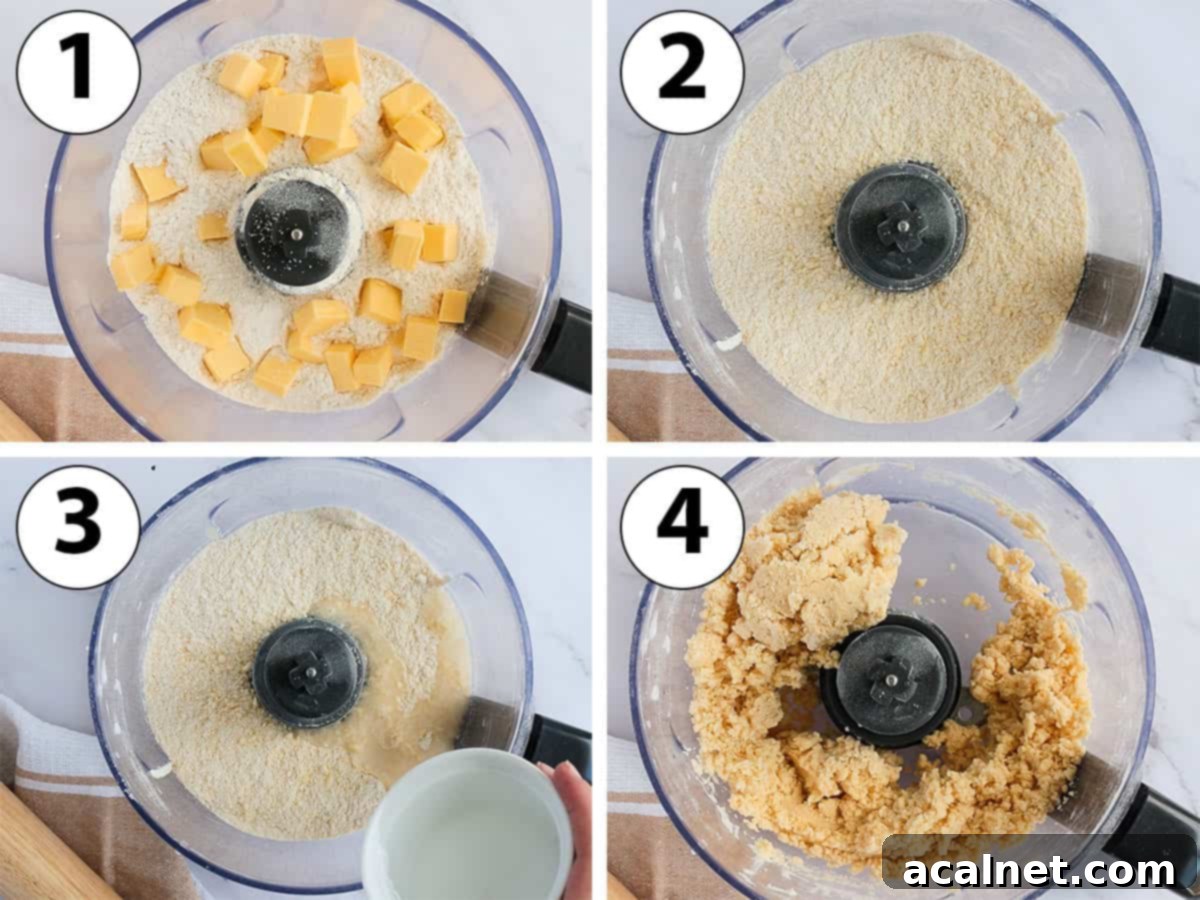
- Photo 1: Combine Dry Ingredients & Butter. In the bowl of your food processor, combine the all-purpose flour and fine sea salt. Add the very cold, cubed unsalted butter. It’s crucial that the butter is cold to achieve a flaky crust.
- Photo 2: Process Until Crumbly. Pulse for approximately 30 seconds until the mixture resembles coarse crumbs with very small pieces of butter remaining. Larger butter crumbs will result in a flakier pastry, but too large can make it prone to collapsing. Aim for pea-sized or smaller.
- Photo 3: Add Cold Water Gradually. While the food processor is running, slowly drizzle in the very cold water. The exact amount of water may vary slightly depending on your flour brand and humidity, so add it cautiously.
- Photo 4: Form a Rough Dough. Continue to blend just until a rough dough begins to come together. Avoid over-mixing, as this develops gluten and can lead to a tough crust. To check if it’s ready, press a handful of the crumbs together; if they stick and form a cohesive dough, it’s done. If it’s still too dry and crumbly, add a tiny bit more cold water, a teaspoon at a time.
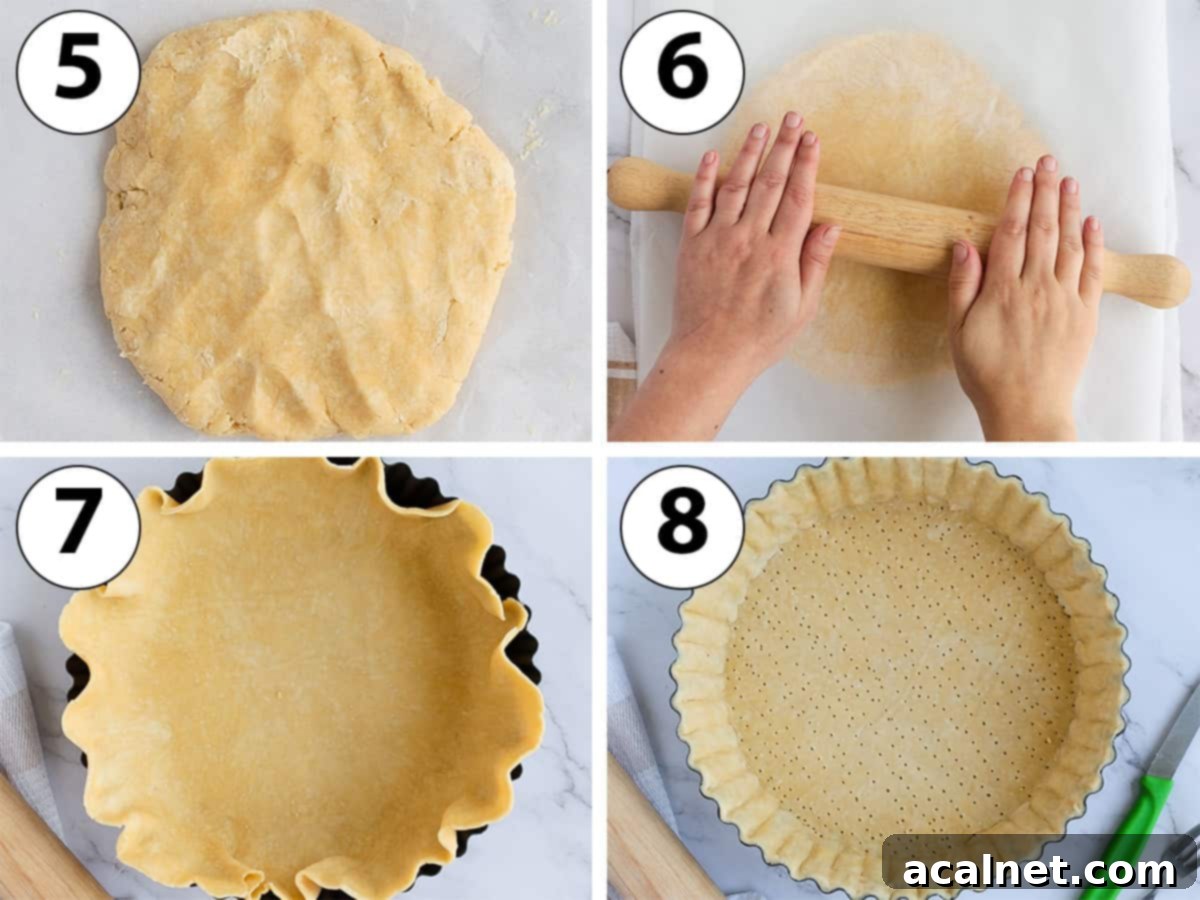
- Photo 5: Shape and Flatten. Transfer the rough dough onto a large sheet of baking paper or parchment paper. Gently bring it together with your hands to form a ball, then flatten it slightly into a disk.
- Photo 6: Roll and Chill. Cover the dough with a second sheet of baking paper and use a rolling pin to roll it into a wide, even disk, about 4 mm (1/6-inch) thick. This method prevents sticking and makes transfer easier. Place the rolled dough on a flat tray and refrigerate for at least 1 hour, or ideally, overnight. Chilling is essential for the gluten to relax, preventing shrinkage during baking and allowing the butter to firm up.
- Photo 7: Line the Pan. Remove the chilled pastry from the fridge and carefully peel off the baking paper. Allow it to sit at room temperature for about 5 minutes to soften slightly, making it easier to handle without cracking. Gently transfer the pastry into a 24 cm / 9.5-inch quiche pan with a removable bottom. Carefully press the pastry into the bottom and up the sides of the pan, ensuring it adheres well and there are no trapped air bubbles. Use a small, sharp knife to trim any excess dough from the edges.
- Second Chill: Place the lined tart pan back in the fridge to chill for another minimum of 1 hour, or preferably overnight. This second chilling step is key to preventing the crust from shrinking in the oven and ensuring a crisp, stable base.
- Photo 8: Blind Bake the Crust. Preheat your oven to 160°C (325°F). While the oven preheats, place your chilled quiche crust in the freezer for about 10-15 minutes. This helps the butter firm up one last time before hitting the heat. Once firm, dock the bottom of the pastry generously with a fork to prevent it from puffing up. Line the pastry with baking paper and fill it with baking weights (such as ceramic pie weights, dried beans, or rice). Par-bake for 15 minutes.
- Finish Blind Baking: Remove the baking weights and parchment paper, then continue to bake for an additional 10 to 15 minutes. This second phase without weights helps to further dry out and lightly brown the crust, creating a crucial barrier against a soggy bottom. Once par-baked and golden, set the crust aside to cool completely while you prepare the filling.
Preparing the Delicious Leek Filling
The leek filling adds a sweet, savory depth to the quiche. Proper preparation is essential for tender and flavorful leeks.
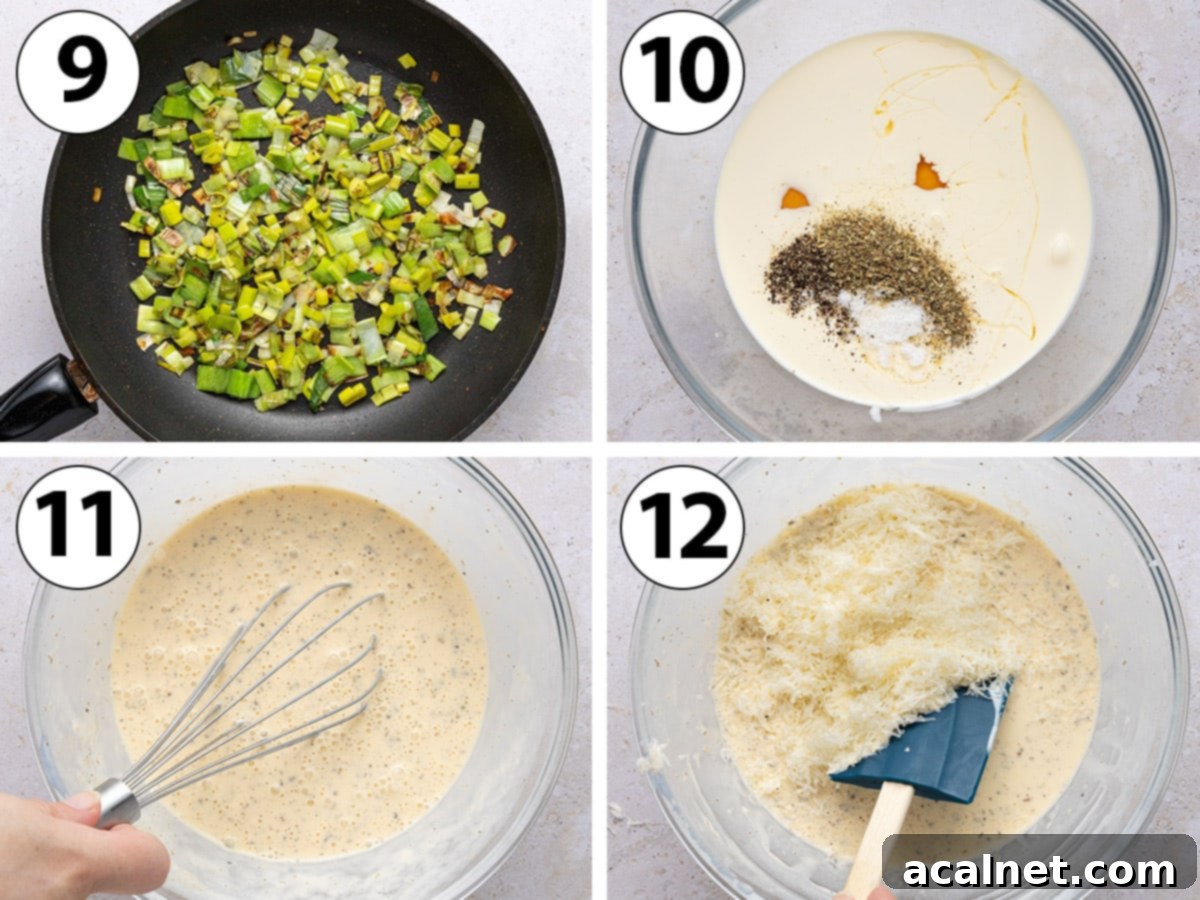
- Prepare the Leeks: Begin by thoroughly washing the leeks to remove any dirt or grit trapped between their layers. Trim off and discard the very bottom root end (about 2 cm from the white part) and the tough, dark green tops. Slice the leeks in half lengthwise, then finely chop them into crescent shapes.
- Photo 9: Sauté the Leeks. Heat a large skillet or saucepan over medium heat. Add the olive oil, then introduce the chopped leeks, a pinch of salt, and pepper. Cook for about two minutes, stirring occasionally, until they begin to soften. Then, add the minced garlic and continue to cook for another 5 minutes, or until the leeks are tender, translucent, and lightly caramelized. This step is crucial for developing their sweet, savory flavor. Remove from the heat and set aside to cool slightly.
- Photos 10 & 11: Whisk the Custard Base. In a separate large bowl, whisk together the large eggs, thickened/heavy cream, remaining salt, pepper, and dried herbs until they are just combined. Be careful not to over-whisk, as this can introduce too much air, leading to a bubbly or cracked surface on your quiche.
- Photo 12: Incorporate the Gruyère. Gently fold in the finely grated Gruyère cheese. This ensures the cheese is evenly distributed throughout the custard, contributing to a rich, cheesy flavor in every bite.
Assembling and Baking Your Leek Quiche
With your crust par-baked and your filling ready, it’s time to bring it all together for the final bake.
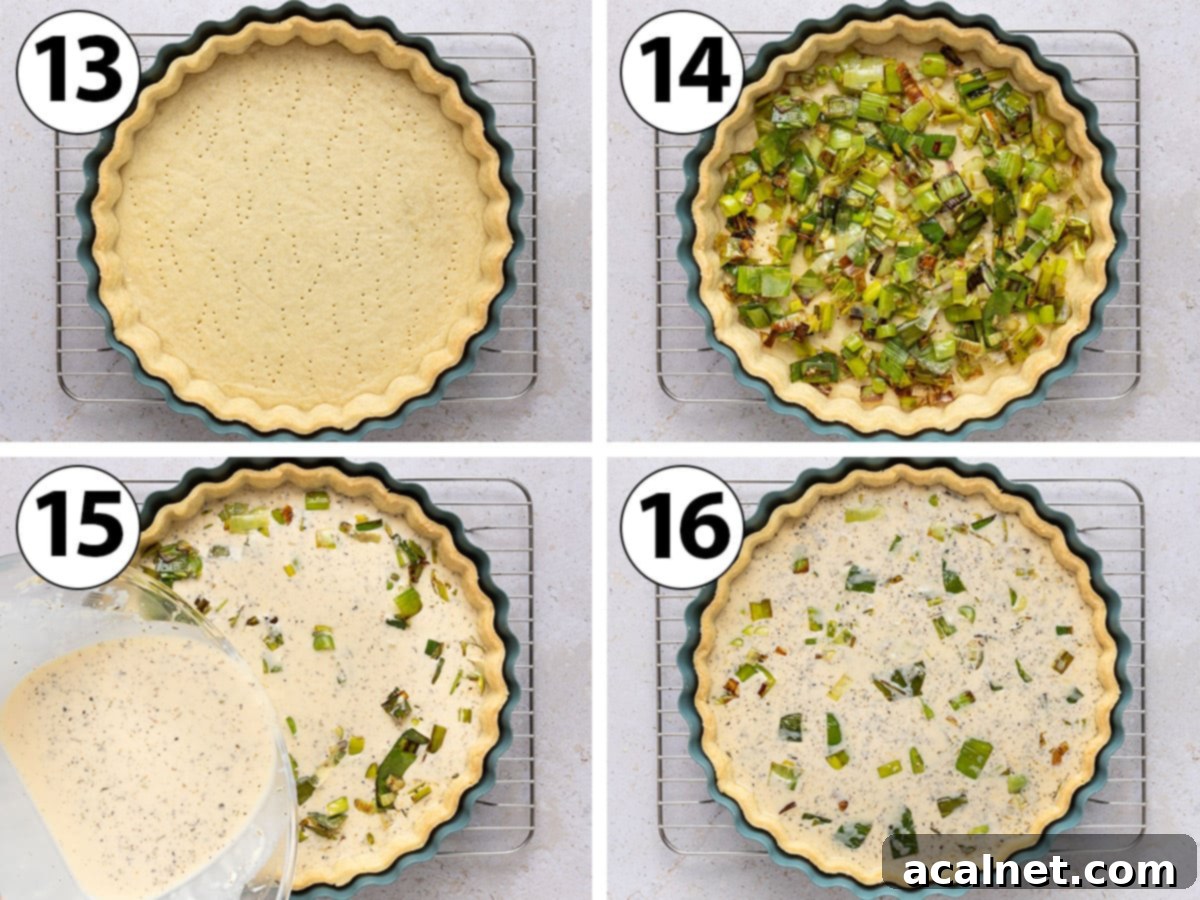
- Preheat your oven to 180°C (350°F). Ensure your oven is fully preheated for even baking.
- Photos 13 & 14: Layer the Leeks. Evenly spread the cooled, cooked leeks over the bottom of your par-baked quiche pastry.
- Photos 15 & 16: Pour the Custard. Carefully pour the egg and cream mixture over the leeks. For an extra cheesy touch and a beautiful golden crust, you can optionally sprinkle a little more grated Gruyère cheese on top.
- Bake to Perfection. Gently transfer the quiche into the preheated oven. Bake for 30 to 40 minutes, or until the custard filling is set and the top has achieved a beautiful golden brown color.
To confirm the quiche is fully baked, gently (and carefully!) shake the pan. The center of the quiche should appear mostly set, with only a slight, very subtle jiggle. Remember, the custard will continue to set as it cools.
If you notice the crust browning too quickly before the filling is set, simply cover the quiche loosely with aluminum foil and continue baking until done. This prevents burning while allowing the custard to finish cooking.
- Cool Before Serving: Once baked, remove the quiche from the oven and allow it to cool on a wire rack for at least 15 to 20 minutes before slicing and serving. This resting time is crucial for the custard to fully set and for easier, cleaner slices.
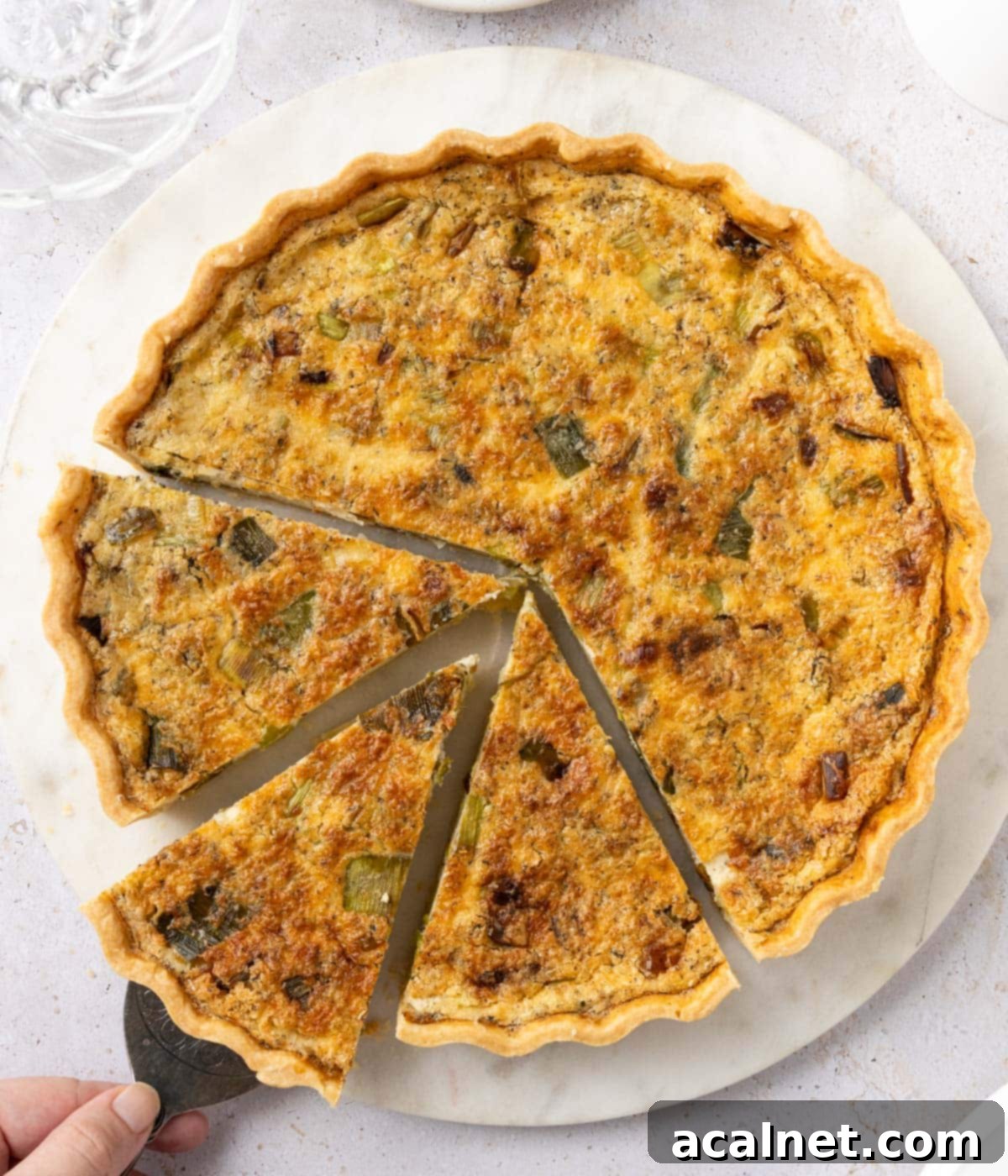
Frequently Asked Questions About Leek Quiche
While our homemade shortcrust pastry is highly recommended for its superior flaky texture and savory balance, you absolutely can use store-bought pastry for convenience. If choosing pre-made pastry, opt for a plain or unsweetened variety, as many store-bought options can be slightly sweet. Alternatively, puff pastry can also be used for a different, lighter texture, but be aware that baking times may vary, and puff pastry tends to become soggy more quickly than a traditional shortcrust.
Yes, par-baking (or blind-baking) the quiche crust is an essential step to prevent a soggy bottom and ensure a perfectly crisp base. This process is divided into two parts:
The first half involves baking the crust with pie weights (such as ceramic weights, dried rice, or chickpeas) to keep the pastry from puffing up or shrinking during baking.
The second half is performed without any weights or coverings, allowing the pastry to dry out and lightly brown as much as possible before the moist filling is added. This creates a crucial barrier for a perfectly baked, non-soggy crust.
This Leek and Gruyère Quiche is wonderfully versatile in how it can be served. It’s truly delicious on its own, allowing its rich flavors to shine. For an added touch of creaminess, top each slice with a dollop of fresh crème fraîche or sour cream. It also pairs beautifully with a simple, crisp green salad dressed with a light vinaigrette, offering a refreshing contrast to the quiche’s richness.
Absolutely! This leek quiche recipe is highly adaptable. You can easily incorporate other vegetables like sautéed mushrooms, spinach (ensure it’s well-drained), thinly sliced asparagus, or even roasted bell peppers. Just make sure to pre-cook any added vegetables to remove excess moisture and prevent them from making the quiche watery.
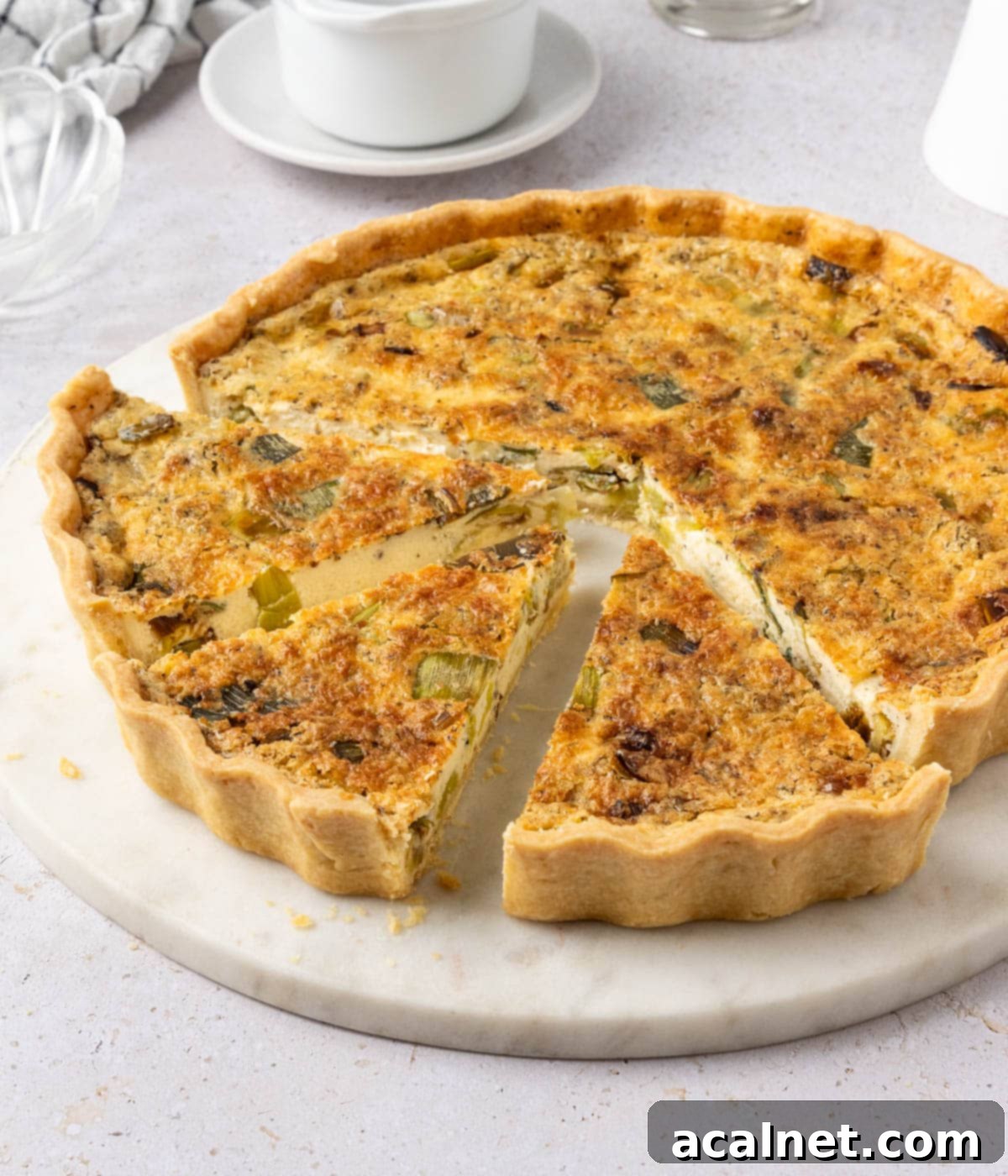
Pro Tips & Troubleshooting for the Best Quiche
Achieving quiche perfection is easy with these expert tips and solutions to common challenges:
- Perfect Quiche Pastry: The secret to a stable, non-shrinking, and beautifully flaky crust lies in proper resting and chilling. Chilling the dough twice—once after rolling and again after lining the tart pan—is absolutely crucial. For optimal results, aim to chill the lined pastry in the fridge overnight. This allows the gluten to fully relax and the butter to firm up completely, preventing any undesirable movement or collapse during baking.
- Knowing When Your Quiche is Baked: To check for doneness, gently (and carefully, using oven mitts!) give the quiche pan a slight shake. The center of the filling should appear mostly set with only a very slight, almost imperceptible jiggle. It will continue to firm up as it cools, so avoid over-baking. An internal temperature of around 77°C (170°F) at the center also indicates it’s done.
- Preventing a Soggy Bottom Crust: This is arguably the most common quiche concern! The key is thorough blind-baking. You want to “dry out” the bottom of the pastry as much as possible before introducing the moist custard. Our two-stage blind-baking process—first with baking weights to hold its shape, then without to thoroughly dry and lightly brown the base—is designed to achieve a perfectly crisp, non-soggy crust every time.
- Preventing a Cracked Quiche Top: Over-baking or baking at too high a temperature can sometimes cause the custard to crack. Ensure your oven temperature is accurate and don’t bake beyond the recommended time. If you notice cracking, it might indicate it’s slightly overcooked.
- Achieving Golden Brown Perfection: For a beautifully golden top, you can finish the last few minutes of baking under a broiler (grill) on low, but watch it very closely to prevent burning. Alternatively, a sprinkle of extra grated Gruyère cheese on top before baking will melt and brown into a delicious crust.
Storing & Freezing Your Leek and Gruyère Quiche
This quiche is fantastic for making ahead or enjoying later. Here’s how to store and freeze it effectively:
- Storing: The leek quiche tastes best when served within 24 hours of baking. However, it will remain delicious for up to 3 days when stored properly in the refrigerator. Ensure it’s tightly covered with plastic wrap or aluminum foil to prevent it from drying out or absorbing other odors.
- Reheating:
- Whole Quiche: To reheat an entire quiche, cover it loosely with aluminum foil and bake in a preheated oven at 180°C (350°F) for approximately 20 minutes, or until warmed through.
- Individual Slices: Single slices can be reheated in the oven for 10 to 15 minutes. While convenient, reheating slices in the microwave is possible, but it often makes the pastry soggy. For a crispier crust, the oven is always the preferred method.
- Freezing: This quiche freezes exceptionally well! You can freeze it whole or cut into individual slices for convenient grab-and-go meals. Make sure to wrap it thoroughly first with a layer of plastic wrap, then with a layer of aluminum foil, to protect it from freezer burn. Thaw the frozen quiche in the refrigerator overnight before reheating in the oven as described above.
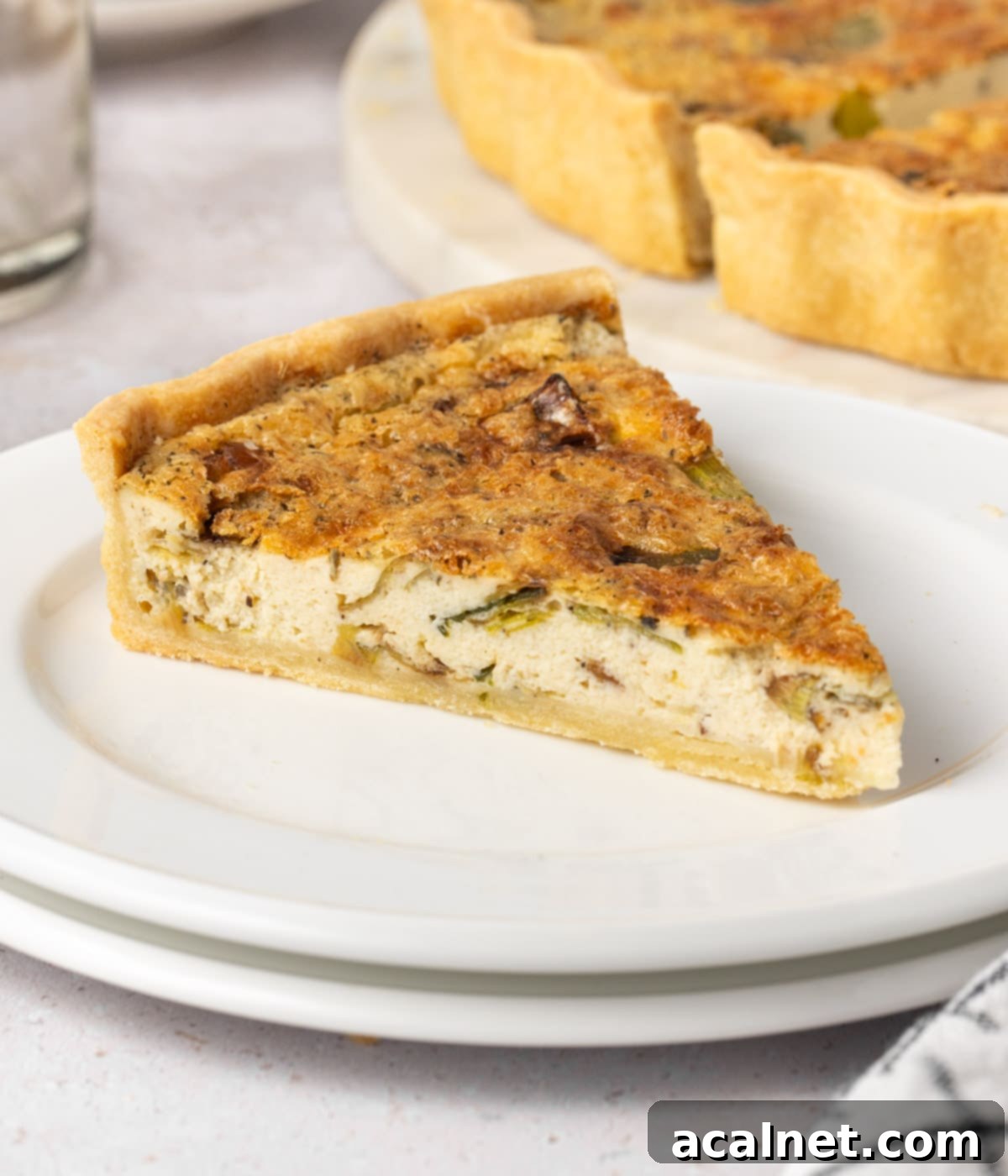
Explore More Delicious Quiche Recipes
If you loved this Leek and Gruyère Quiche, you’ll certainly enjoy exploring our other savory quiche creations. Each recipe offers a unique blend of flavors, perfect for any occasion:
- Feta Asparagus Quiche
- Cheese and Tomato Quiche
- Spinach and Feta Quiche
- Roasted Pumpkin Quiche
- Broccoli and Cheddar Quiche
- Zucchini Quiche with Feta and Mint
- Mushroom and Spinach Quiche
I am so excited to share that my debut cookbook
“Bite-Sized French Pastries for the Beginner Baker”
is now available for purchase!
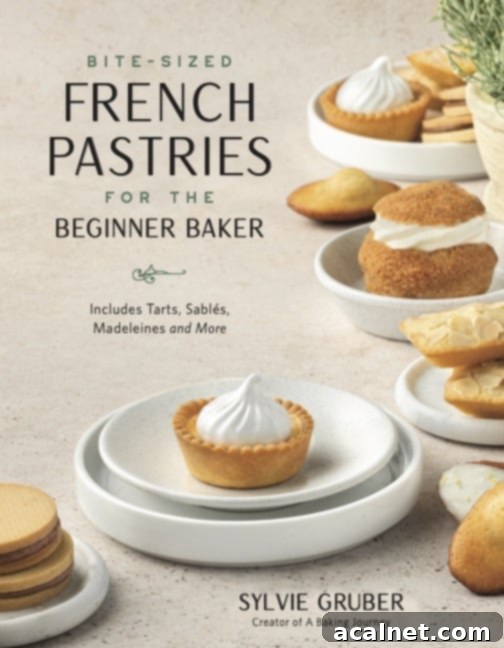
Full Recipe Details
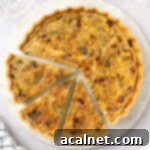
Leek Quiche with Gruyère
Servings:
8
Author:
Sylvie
45 minutes
1 hour
2 hours
3 hours
45 minutes
Print Recipe
Equipment
- 24 cm / 9,5-inch Quiche Pan with removable bottom plate
Ingredients
Quiche Pastry
- 200 gr Plain / All-Purpose Flour
- 1/2 teaspoon Fine Table Salt
- 100 gr Unsalted Butter, cubed, very cold
- 65 ml Water, very cold
Leek Filling
- 1 large Leek, about 200 gr sliced
- 1/2 tablespoon Olive Oil
- 1/2 teaspoon Fine Table Salt
- 1/3 teaspoon Ground Pepper
- 1 teaspoon Minced Garlic
Custard Filling
- 4 large Eggs
- 300 ml Thickened / Heavy Cream, 30% fat content min.
- 1 1/2 teaspoon Fine Table Salt
- 1/2 teaspoon Ground Pepper
- 1 teaspoon Dried Herb Mix
- 40 gr Gruyère Cheese, grated
Instructions
Quiche Pastry
- In the bowl of a food processor (see note 1), mix together the Flour, Salt and very cold cubed Butter. Blend for about 30 seconds, or until you can see very small crumbs of butter (see note 2).
- Slowly add the very cold water while mixing. Continue to blend until a rough dough starts to come together. To know the pastry is ready, press some of the dough crumbs inside your hand. If they stick together and turn into a smooth dough, it is ready. If still dry and crumbly, add a little bit more cold water.
- Place the dough over a large sheet of baking paper, bring it together into a ball and slightly flatten it. Cover with a second sheet of baking paper and roll into a large disk that is approximatively 4 mm thick (1/6 inch) using a rolling pin. Transfer over a flat tray and refrigerate for at least 1 hour.
- Remove the baking paper and leave at room temperature for about 5 minutes to slightly soften the pastry. Place inside a 24 cm / 9,5-inch Quiche Pan with removable bottom. Gently slide the pastry down the sides and bottom of the pan and press to make it stick to the pan. Use a small sharp knife to remove any excess dough.
- Place in the fridge to chill for at least 1 hour, preferably overnight (see note 3).
- Preheat your oven on 160 degree Celsius (325 degree Fahrenheit) and place the pastry in the freezer while it is preheating. Poke small holes at the bottom of the pastry using a fork then cover with baking paper and fill with baking weights. Bake for 15 minutes then remove the weights and baking paper and bake for an additional 10 to 15 minutes. Set aside to cool down.
Leek Filling
- Wash the Leek to remove any dirt. Cut out and discard the bottom part of the leek’s white side and the top part of its green parts. Slice the leek in half lengthwise then finely chop.
- In a large saucepan over medium heat, place the olive oil then the chopped leek, salt and pepper. Toss and cook for two minutes, then add the minced garlic. Cook for another 5 minutes or until the leeks are soft and lightly caramelised. Remove from the heat.
Custard Filling
- In a large bowl, whisk together the Eggs, Cream,Salt, Pepper and Dried Herbs until just combined. Fold in the grated Gruyère Cheese.
Assembling the Quiche
- Preheat your oven on 180 degrees Celsius / 350 degrees Fahrenheit.
- Place the cooked leeks at the bottom of the par-baked quiche pastry and pour the custard mixture over. Optionally, top the quiche with a little bit more grated cheese.
- Carefully place in the oven and bake for 30 to 40 minutes or until the custard filling has set and the top looks golden (see note 4). Take out of the oven and allow to cool down for 15 to 20 minutes before serving.
Would you like to save this recipe?
We’ll email this post to you, so you can come back to it later!
Notes
- If you don’t have a food processor, the pastry can also be made by hands. You can read the instructions to make it by hands in my Savoury Shortcrust Pastry recipe.
- The larger the butter crumbs are, the flakier the pastry will be – but that also increases the chance of collapsing in the oven when baking. For a stable yet flaky crust, aim for pea-sized butter pieces.
- Resting and chilling the pastry twice is key to get a crust that does not move, shrink or collapse in the oven. You will get the best result by chilling the pastry overnight once lined inside the tart pan. This will allow for the gluten to completely relax and the butter to be very cold.
- To know the quiche is baked, gently shake the pan back and forth. The centre of the quiche should not jiggle and appear mostly set. If the crust seems to be browning (or burning) before the quiche is ready, you can cover the quiche with aluminum foil and continue to bake.
Nutrition (per serving)
Made this recipe?
Let us know if you liked it by leaving a comment below, and tag us on Instagram @
a.baking.journey with a photo of your creation!
